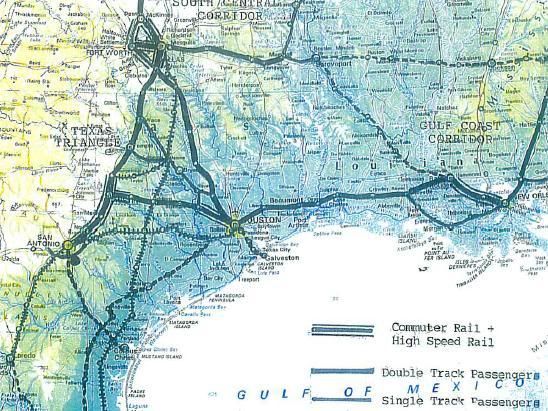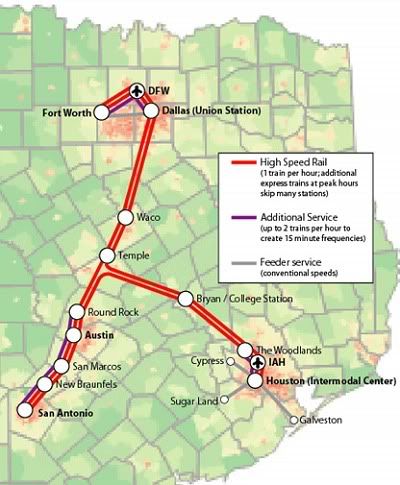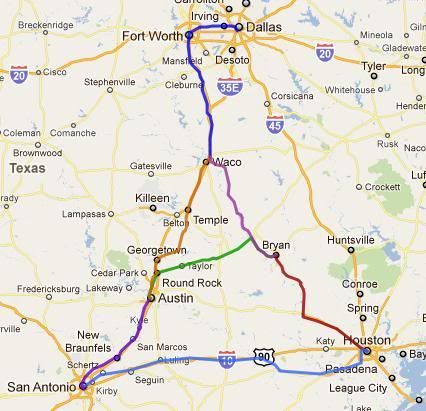(4 pm. – promoted by ek hornbeck)
Burning the Midnight Oil for Living Energy Independence
 Back in the 90’s, Texas tried to get an Express HSR system off the ground (that is, a bullet train system somewhere in the 125mph to 220mph range) with the “Texas Triangle” project. It was to be an entirely privately funded project. Not surprisingly, competing against the heavily publicly subsidized interstate highway and air travel systems, it did not get off the ground.
Back in the 90’s, Texas tried to get an Express HSR system off the ground (that is, a bullet train system somewhere in the 125mph to 220mph range) with the “Texas Triangle” project. It was to be an entirely privately funded project. Not surprisingly, competing against the heavily publicly subsidized interstate highway and air travel systems, it did not get off the ground.
More recently, the Texas T-Bone was proposed, based on the Dallas to San Antonio leg of the Triangle and a route from Houston to Temple, then running north to Dallas with connections south to Austin and San Antonio.
While the Texas T-Bone seems to be the current plan of the Texas High Speed Rail and Transportation Corporation, this is more of an advocacy group than an official HSR Commission or Rail Development Commission.
Given that we are in between periods of substantial federal funding for High Speed Rail, I thought this might be a good time to take a look at the prospects for Regional HSR, in some of the existing rail corridors within the “Texas Triangle” region … and so arrived at the Texas Wishbone.
What Went Wrong?
 Texas actually put in a bid for substantial Federal funding to get a $1.9b start on the Texas T-Bone. However, the bid was almost completely unsuccessful, as discussed in a Houston Chronicle editorial (which in its overview of the facts of the matter puts much supposed “news reporting” on HSR to shame):
Texas actually put in a bid for substantial Federal funding to get a $1.9b start on the Texas T-Bone. However, the bid was almost completely unsuccessful, as discussed in a Houston Chronicle editorial (which in its overview of the facts of the matter puts much supposed “news reporting” on HSR to shame):
…
Call it what you will – Texas Triangle, Texas T-bone – the state’s proposed high-speed intercity rail line is the proverbial no-brainer. It would connect three of the nation’s 10 largest cities, serving an area bounded by Houston, Dallas-Fort Worth and San Antonio that is projected by the state demographer to have a population of 40 million by the year 2040. It would ease already intolerable congestion on Interstate 35 between the Dallas area and San Antonio. And, unlike other projects, notably the one proposed in California, it would be reasonable to build on gently rolling Texas farm and ranch land that is, by comparison with most other corridors, reasonably priced.What’s not to like about such a plan? And why, for heaven’s sake, weren’t its praises being sung to the heavens before the Washington decision-makers?
Two important things have caused Texas grief in Washington, according to Harris County Judge Ed Emmett, who has spent most of his professional life dealing with transportation issues at the county, state, national and international levels. Emmett says:
[*] The lack of a direct connection between Dallas and Houston in the proposed Texas T-bone route has caused many involved at the federal level to question whether Texas is really serious about high-speed rail. …
[*] The state’s interests would be best served by a formal government voice . Such a voice, says Emmett, would communicate a level of seriousness and commitment that is clearly needed in Washington.
The Lay of the Land
 The map to the right includes selected rail corridors within the “Texas Triangle” region. Some of these are primary rail transport corridors, and some are secondary ~ when Google shows some rail line going along an alignment that takes it by a major airport or a Texas University, I have taken that alignment even if its not the mainline alignment.
The map to the right includes selected rail corridors within the “Texas Triangle” region. Some of these are primary rail transport corridors, and some are secondary ~ when Google shows some rail line going along an alignment that takes it by a major airport or a Texas University, I have taken that alignment even if its not the mainline alignment.
Note that rather than taking a right hand turn at Temple to get to Dallas/Fort Worth, the Dallas / Houston alignment merges with the Dallas / San Antonio alignment on the north edge of Waco. Just focusing on Houston / Dallas, that allows for a reasonably straight Houston to Fort Worth alignment, with the right turn taking the train near Dallas / Fort Worth aiport and to downtown Dallas.
The long term plan would be to first establish the principle corridors, and then upgrade the speed in stages:
- Start with a 110mph maximum, diesel hauled corridor, with a dedicate rail along heavily used freight rail corridors and 10 miles in 50 miles passing track along more lightly used freight rail corridors. This may be able to achieve 70mph transit speeds.
- In response to ridership, progressively upgrade segments to electric 125mph corridor, on all high speed track (though the track could be shared with suitable 100mph single stack container freight trains, if doing so accelerated generation of an operating surplus by the public track operator). This may be able to achieve 100mph transit speeds.
- Then on an incremental basis, full grade separation and upgrade of the track signaling to support 160mph operation. This may be able to achieve 125mph transit speeds.
The main reason for drawing these multi-colored segments is so that I can get Google maps to tell me how long each segment is. Some of these distances are more precise than others ~ for example, I just worked out today that what looked like two terminating lines in Columbus, TX was just Google Maps obscuring the rail corridor with a street, so that the Houston / San Antonio segment is just a rough sketch, and missing the various bends along the way, the distance will be a little short. Most of these, however, will be correct rail alignment distances within a few miles:
- Dallas / Fort Worth / Waco: 120 miles
- Waco to Austin: 111 miles
- Austin to San Antonio: 83 miles
- Waco to Bryan: 88 miles
- Austin to Bryan: 108 miles
- Bryan to Houston: 100 miles
- Houston to San Antonio: ~210 miles
These segments gives the following trip distances, with express trip times assuming 70mph, 100mph and 125mph transit speeds:
- San Antonio / Austin: 83 miles; 1:11 / 0:50 / 0:40
- Houston / Austin: 208 miles; 2:58 / 2:05 / 1:40
- San Antonio / Houston: 210 miles; 3:00 / 2:06 / 1:41
- Dallas / Austin: 231 miles; 3:18 / 2:19 / 1:51
- Dallas / Houston: 308 miles; 4:24 / 3:05 / 2:28
- Dallas / San Antonio: 314 miles; 4:29 / 3:08 / 2:31
From this, we can see why the focus on the three largest metro areas that define the Texas Triangle leads toward an immediate roll-out of Express HSR. At the lower end of 110mph maximum rail corridors, San Antonio to Houston just barely hits the 3hr threshold that allows rail travel into the markets for many single-day trips, and the Dallas trips are way out of range.
However, Houston / San Antonio and San Antonio / Austin certainly both make sense even as incremental improvements on existing corridors to reach 110mph. And Houston through College Station to Austin is also workable at that level. Indeed, for the alignments I have sketched above, that can be run as a single two way loop route, Houston / College Station / Austin / San Antonio / Houston and return. Given the distance between Austin and San Antonio, that first leg might involve going as far north as Temple and a spur to Fort Hood, as the Austin / San Antonio leg is likely to support greater frequency than the Houston / Austin and Houston / San Antonio legs, and a San Antonio / Austin / Fort Hood service would provide a useful way of filling in additional Austin / San Antonio frequencies.
In the second stage, upgrade that loop to the 125mph tier, and now the “Dallas wishbone” legs come into the frame, so in the third stage, establish the Dallas / Waco, Waco / Austin, and Waco / Bryan legs as 125mph corridors from the outset, adding Dallas / Houston and Dallas / San Antonio services to the existing HSA Loop.
And then the fourth stage is the provision of full grade separation and signaling to allow Express HSR class of operation. The full grade separation is a substantial increase in cost, and so it is an open question which specific corridors would generate a benefit to justify the extra cost. However, experience with the 125mph services would support firm ridership projections, so that there would be a substantial opportunity to seek revenue bonding for part or all of the state matching funds required.
Prelude to a Bullet Train
As observed when the Texas bid for HSR funding fell through, Florida was successful when Texas was not because Florida got all of its ducks in a row, with local, state and federal support all lined up behind the project being established. Of course, it then lost the money again as rogue ducks invaded the place and upset all of its carefully laid plans … but original lesson still holds.
If Texas is going to be in a position to strike next time that high speed rail funding becomes available, Texas needs to establish a state government authority with responsibility and with funding to pursue planning and environmental studies. It needs to have shovel ready projects.
And while it is fine for that organization to develop plans for bullet trains at the outset, it might prove difficult to organize the state level funding that may be required as state matching grants for federal HSR funding.
The Texas Wishbone offers a lower funding hurdle to get over. First, the first stage corridor is substantially less expensive to get established, so the level of state “seed money” required for state matching funds would be substantially less than for a bullet train system. And second, if the frequency of the initial Houston / San Antonio / Austin loop is tailored to the market demand, the service will generate an operating surplus, and that surplus can be dedicated to contributing state matching funds for further expansion.
Of course, before Stage 1 comes the even more important Stage 0: establishing a HSR department in a Rail Development Commission or Rail Division in the TxDOT, to flesh out both Express and Regional HSR plans and have a set of plans ready to break ground, at some time that federal funding for HSR becomes available.
And it must be stressed that this is not an alternative to establishing a direct 220mph HSR corridor from Houston to Dallas. It is, indeed, one of several paths to take toward that longer term goal. As the Texas Wishbone fills out, the experience in operating the Texas Wishbone services will be providing information to support the business case, and the operating surpluses from built-out Texas Wishbone should be accumulating as state matching funds for establishing that corridor.
Midnight Oil ~ Truganini

1 comments
Author
I dunno, Croatian maybe?